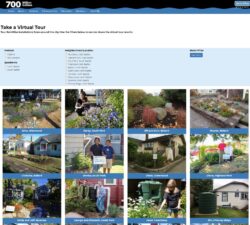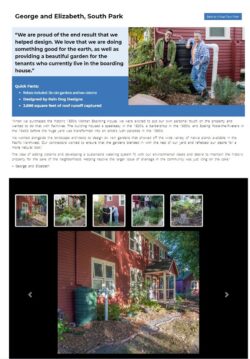Second in the EYAWTKA series. This post is an annotated and tightly edited list of resources on green infrastructure for managing stormwater, water pollution and urban climate adaptation that I don’t think you can find all in one place anywhere else. It began just as some reminders to myself and then I figured maybe others might find it useful. It’s far from comprehensive but it is highly selective – for every link here, many less optimal ones were weeded out. Specialists may want to skip to the BMP tools and databases farther down.
Green infrastructure is a set of methods for cities to prevent flooding and water pollution by incorporating nature in built structures instead of fighting it by just building ever bigger structures with ever more concrete. It’s a subset of what is often called nature-based solutions, best management practices (BPM) or low-impact development(LID). These terms aren’t identical but they overlap considerably, and further, they don’t have standardized definitions, although green infrastructure itself arguably has a more specific and distinct definition than the others. That being said, green infrastructure has an entirely different meaning in the US than it does in Europe, where it refers to any and all parts of the landscape that are not built – forests, parks, meadows, gardens, lawns, everything. In the US it means built structures that use natural processes.
For non-specialists
The results of a long ongoing struggle to find introductions to green infrastructure targeted to people who don’t know what it is, yet who need more than just an article. Oddly, it’s very hard to find good images of green infrastructure despite the field’s runaway growth in the past two decades, which is a shame because it’s hard to visualize based on just a verbal description. So I made sure to find sources with excellent visuals.
The Value of Green Infrastructure: A Guide to Recognizing Its Economic, Environmental and Social Benefits. Center for Neighborhood Technology.
Greening DC Streets. A Guide to Green Infrastructure in the District of Columbia. Washington D.C. Department of Transportation.
A Homeowner’s Guide to Stormwater Management. Philadelphia Water Department.
It’s raining harder and harder, and our city can’t handle it. The Amsterdam Rainproof Brochure. City of Amsterdam.
Special mention for pointless deletion of a good resource: The City of Seattle used to have a page of virtual tours where residents showed the raingardens they had built in their own yards, but they deleted it. Screenshots:


Interactive green infrastructure maps
Special mention for pointless deletion of a good resource #2: You used to be able to click on each raingarden on the NYC map and pull up a photo. That’s gone now.
Philadelphia – Green infrastructure map
Philadelphia – two wonderful story maps that masterfully integrate ecological walking tours and environmental history with green infrastructure (Cobb’s Creek) and restoration of a degraded stream (Morris Park)
Portland – This is a map of the Green Street Stewards program where residents adopt curbside raingardens and apparently not a map of all the green infrastructure.
Projects for schools and students
Rain gardens – complete instructions for schools, community groups, scouts etc. on how to plan and build one. Rhode Island Department of Environmental Management.
A Guide to Stormwater Management on School Campuses. Projects for K-12 students, everything from raingardens to wildflower meadows to vehicle washing. Phildelphia Water Department.
City Habitats: Transform your community to turn the tide on polluted runoff. Brief but excellent booklet for around grades 5-6 packs the science and activities into just eight pages. Was an insert in the Seattle Times newspaper
Education
There are hundreds of lesson plans on green infrastructure and stormwater for K-12 and adult education and outreach out there, on top of the countless others on many other water topics, as an internet search will quickly reveal. The two sites below are especially comprehensive and the third is an ingenious low-tech portable working sewer model.
Teachengineering.org – many, many lesson plans on every aspect of water management, from University of Colorado.
“Rain to Drain” and many more lesson plans at Penn State Extension.
Sewer in a Suitcase – Sheer genius. I love this. Just what it says – a model of a combined sewer using actual water, in a suitcase, suitable for all ages. Center for Urban Pedagogy, New York.many, many lesson plans on every aspect of water management, from University of Colorado.
Raingardens – how to build and maintain, for private citizens
How to build a raingarden. Extensive resources at Washington State University.
Guidance Manual for Homeowners: Managing Stormwater Runoff Using Green Infrastructure. This one really walks you through with step-by-step photos. Stormwater Coalition of Albany County
Raingarden Stewardship Program Maintenance Manual. This is for residents who volunteer to maintain sidewalk raingardens owned by the city (“right-of-way bioswales”). NYC Department of Environmental Protection, Harbor Protectors program.
Green Streets Steward Maintenance Guide. Another guide for citizen stewards. City of Portland Environmental Services.
Cultural inclusion
Training and support for green infrastructure construction in Korean, Somali, Tigrayan, Cambodian, Chinese, and Spanish for contractors. Seattle Public Utilities.
Case studies – descriptive
If you just want to see examples of green infrastructure, look here.
Detroit – This is one good because you can filter by type of structure
Urban Resilience Briefs from Urban Land Institute. Only partially on green infrastructure
Case studies – comprehensive database and performance reports
International Stormwater BMP Database – Out of all the resources on this page this is the real powehouse, a comprehensive, exhaustive and sophisticated database of quantitative performance data for over 700 BMP installations in several countries. Generates reports and interactive graphs of research results of every site.
Meta search
Green Infrastructure Wizard (GIWIZ) – Guided search aid for finding reports, case studies, local regulations and planning guidance, modeling software, databases, funding programs, and videos. Huge. I find it easiest to click on “Explore” > “What resources are you interested in?”
Research
Penn State Center for Green Infrastructure and Stormwater Management – Applied research on cutting-edge topics such as cognitive and institutional barriers to the adoption of green infrastructure; visualization tools in green infrastructure decisionmaking, and citizen preferences in non-hydrological benefits of green infrastructure.
BMP selection tools and calculators
All of these are tools for selecting BMPs including but not limited to green infrastructure and modeling their estimated performance and/or cost. As selection tools they are not intended for the design itself.
National Stormwater Calculator
This is the only spatially explicit one: you draw your site on a map, selected your desired BMPs, and enter the percent of the stormwater you want each one to capture. The tool then calculates the performance and cost based on that site’s topography, precipitation, soil and cover type. (EPA)
Allows specific pollutants and site constraints to be entered as search filters. Reports operating costs, maintenance requirements, lifespan, performance data and construction tips for each BMP. (Interstate Technology and Regulatory Council)
Green Values Stormwater Management Calculator
Calculates costs and benefits of various BMPs. The least technical and specialized of these tools. (Center for Neighborhood Technology)
EPA Best Management Practices Siting Tool
Requires ArcMap. Identifies potential suitable locations/areas for implementing different types of BMPs based on site suitability criteria such as drainage area; slope; hydrological soil group; groundwater table depth; and road, stream, and building buffers.
Visualizing Ecosystem Land Management Assessments (VELMA) Model
Models the reduction of inputs of nutrients and contaminants by green infrastructue, and fate and transport of water, nutrients, and toxics across multiple spatial and temporal scales. (EPA)
Community-enabled Lifecycle Analysis of Stormwater Infrastructure Costs (CLASIC) Tool
For lifecycle cost-benefit modeling. (EPA / Water Research Foundation)
Comprehensive stormwater modeling tool used worldwide since 1969(! – with continual updates of course). Not specifically focused on green infrastructure. Included here because of its importance.